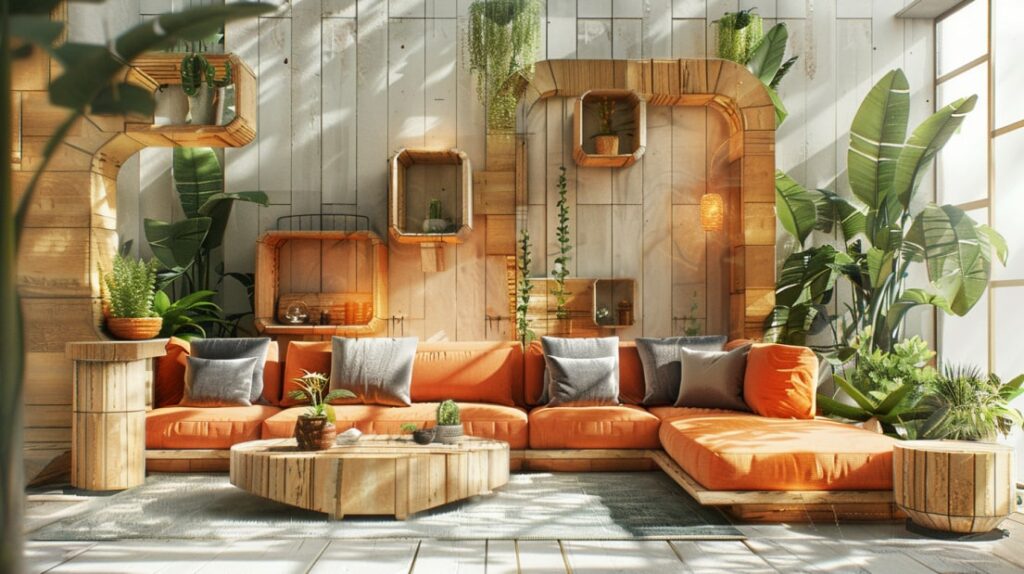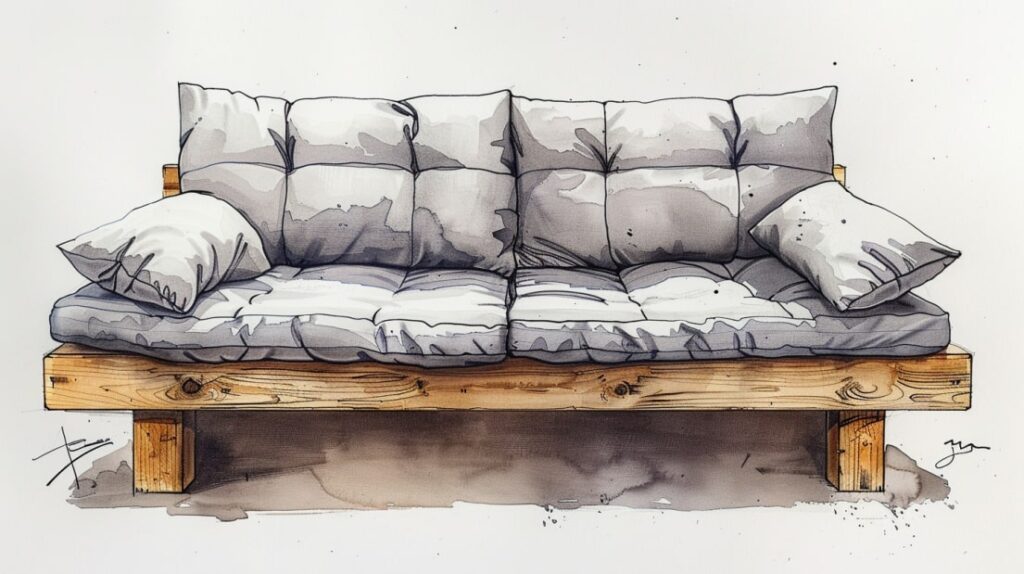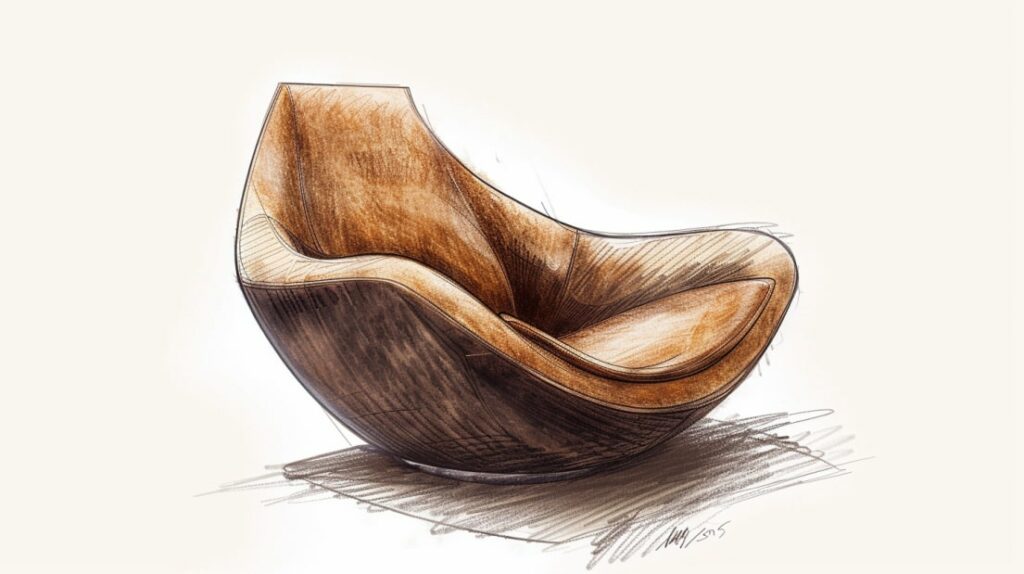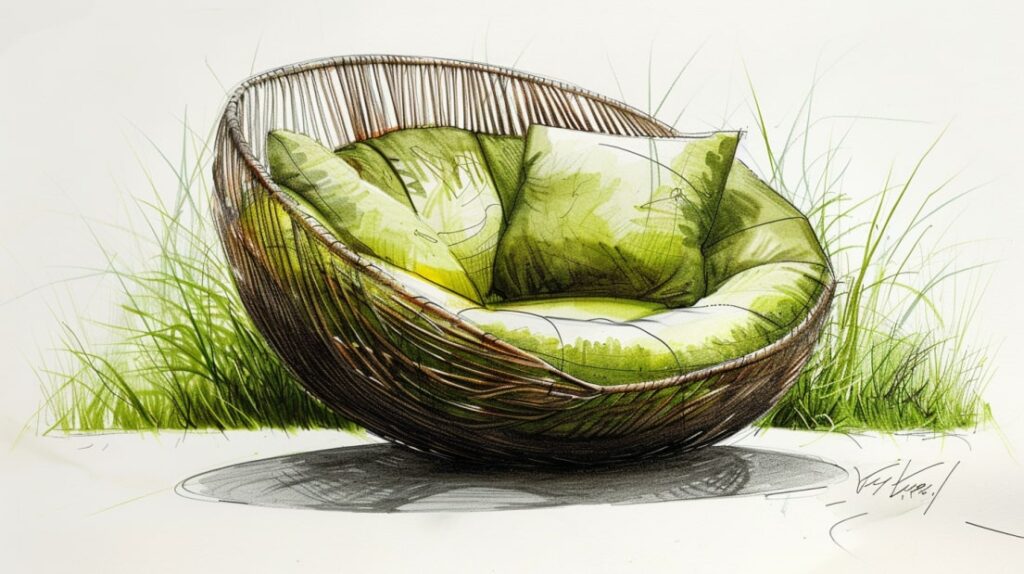Unlock Premium, Members-Only Content
Your source for the most relevant updates in sustainable construction
In our quest for a greener planet, every choice counts—right down to the furniture that adorns our homes. Let’s dive into the world of eco-friendly furniture, where sustainability meets style, and discover how making mindful choices can transform our living spaces and the world around us.
What is Eco-Friendly Furniture?
Eco-friendly furniture whispers the future into our homes, bringing with it a promise of sustainability, responsibility, and an undeniable charm that speaks to both our conscience and our aesthetic sensibilities.
The Core Principles:
- Sustainability: Furniture that gives back to the planet as much as it takes.
- Ethical Manufacturing: Crafted with care, respecting the rights of workers and the environment.
- Longevity and Durability: Built to last, reducing the cycle of waste.
Eco-friendly furniture isn’t just a choice; it’s a statement—a commitment to a lifestyle that prioritizes the health of our planet and its inhabitants.
Why Choose Eco-Friendly Furniture?
Choosing eco-friendly furniture is like voting for the environment with every piece you bring into your home. But the benefits don’t stop at the environmental impact. Let’s break down why making this choice is a win-win situation.
The Triple Win:
- For the Planet: Reduces deforestation, decreases landfill waste, and minimizes toxic emissions.
- For Your Health: Lowers your exposure to harmful chemicals often found in traditional furniture.
- For Your Wallet: Invest in quality and durability, saving money in the long run.
The Impact:
- Environmental: Every sustainable piece helps in the battle against climate change.
- Personal Health: Enjoy cleaner air and a safer living environment.
- Economic: Support companies that prioritize sustainability, driving industry-wide change.

How to Identify Sustainable Furniture Materials
Navigating the world of eco-friendly materials can be a maze, but fear not! Here’s a cheat sheet to guide you through the forest of sustainable options.
The Sustainable Materials List:
- Bamboo: Fast-growing and hardy, bamboo is a superstar in the eco-materials world.
- Reclaimed Wood: Old wood, new life. Each piece tells a story, adding character and charm.
- Recycled Metals and Plastics: Turning yesterday’s waste into today’s treasures.
- Organic Fabrics: Natural fibers that are kind to the earth and your skin.
The Checklist:
When eyeing potential furniture additions, keep this checklist handy:
- Material Source: Is it renewable or recycled?
- Manufacturing Process: Were sustainable practices used?
- Durability and Longevity: Will it stand the test of time?
- End-of-Life Plan: Can it be recycled or repurposed?
Eco-friendly furniture is not just a choice but a reflection of our values and our hope for the future. By embracing sustainable materials and practices, we pave the way for a healthier planet and a more thoughtful approach to the spaces we call home. Let’s continue this journey, one piece of furniture at a time.

Certifications to Look For in Eco-Friendly Furniture
When the forest of eco-friendly choices becomes dense and the path unclear, certifications light the way, offering assurance that what we bring into our homes meets the highest standards of sustainability and ethical manufacturing.
Guiding Stars in the Eco-Furniture Furniture Universe:
- FSC Certified (Forest Stewardship Council): The gold standard for wood. It ensures that products come from responsibly managed forests that provide environmental, social, and economic benefits.
- GREENGUARD: Focuses on indoor air quality, certifying that furniture emits low levels of volatile organic compounds (VOCs), reducing your exposure to pollutants.
- Oeko-Tex Standard: For textiles, this certification guarantees that fabrics are free from harmful chemicals, making your home safer and more comfortable.
The Certification Checklist:
- [ ] FSC Certified: Ensuring the wood’s journey from forest to your living room is responsible.
- [ ] GREENGUARD: Your guarantee for breathing easier.
- [ ] Oeko-Tex: Comfort in knowing your textiles are toxin-free.
Armed with this knowledge, you can navigate the eco-friendly furniture market with confidence, ensuring that your choices are not only good for the planet but also for the health and wellbeing of your family.
Top Sustainable Eco-Friendly Furniture Brands in 2024
In 2024, the vanguard of the eco-friendly furniture movement is more vibrant and diverse than ever. Here are the trailblazers leading the charge, combining innovative design with unwavering commitment to sustainability.
Pioneers of Green Living:
- Green Furniture Concept: Crafting contemporary furniture that’s as stylish as it is sustainable.
- EcoBalanza: Luxurious, handcrafted furniture that proves eco-friendly can also mean luxurious.
- West Elm: A well-known brand that’s committed to sustainability, offering a wide range of FSC-certified products.
Why They Stand Out:
- Innovative Designs: Pushing the boundaries of what eco-friendly furniture can look like.
- Commitment to Sustainability: Not just in materials, but in all aspects of their operations.
- Transparency: Clear about their sourcing, manufacturing processes, and sustainability efforts.

Cost Comparison: Eco-Friendly vs. Traditional Furniture
The myth that eco-friendly furniture automatically means more expensive is just that—a myth. Let’s do a quick dive into the economics of choosing green for your home.
The Price Tag Debate:
- Initial Investment: Eco-friendly furniture can have a higher price tag upfront due to the quality of materials and ethical manufacturing processes.
- Long-Term Savings: Durability and longevity mean fewer replacements, saving money over time.
- Health and Environmental Benefits: Can you really put a price on these?
Breaking Down the Costs:
| Type | Initial Cost | Longevity | Health & Environmental Impact |
|---|---|---|---|
| Eco-Friendly | Higher | Longer | Positive |
| Traditional | Lower | Shorter | Negative |
Investing in eco-friendly furniture is investing in the future—of our planet, our health, and our finances. The upfront cost is a small price to pay for the long-term benefits that sustainable furniture brings to our lives and the world around us.
Join us as we continue to explore the multifaceted world of eco-friendly furniture, where every choice we make is a step towards a greener, healthier future.
Design Trends in Eco-Friendly Furniture
As we sail into 2024, eco-friendly furniture isn’t just about being green; it’s also about making a statement with innovative designs that blend style with sustainability. Let’s uncover the trends setting the eco-friendly furniture world ablaze.
The Trendsetters:
- Minimalism with a Twist: Clean lines meet sustainable materials, proving less is more and green.
- Vintage Revival: Old pieces get a new life, marrying history with modern sustainability ideals.
- Nature-Inspired Tones: Earthy colors and natural textures bring the outdoors in.
Trend Watch Table:
| Trend | Description | Why It’s Hot |
|---|---|---|
| Minimalism | Simple, clean designs using eco-friendly materials. | Emphasizes quality and sustainability without excess. |
| Vintage | Upcycled or restored furniture with a story. | Adds character and reduces waste. |
| Nature-Inspired | Earth tones and natural finishes. | Creates a serene, eco-conscious space. |
Eco-Friendly Furniture for Every Room
Turning your home into a green sanctuary means finding eco-friendly options for each room. Here’s how to do it without sacrificing style or comfort.
Room-by-Room Eco-Friendly Furniture Guide:
- Living Room: Opt for sofas and chairs upholstered with organic fabrics and filled with natural fibers.
- Bedroom: Invest in an FSC-certified wooden bed frame and organic cotton linens.
- Office: Choose desks and chairs made from bamboo or recycled materials.
The Eco-Friendly Furniture Room Checklist:
- Living Room: [ ] Sustainable sofas, [ ] Eco-friendly coffee tables, [ ] Organic throws.
- Bedroom: [ ] FSC-certified bed frames, [ ] Organic bedding, [ ] Natural fiber rugs.
- Office: [ ] Bamboo desks, [ ] Recycled material chairs, [ ] Non-toxic paint.
The Role of Recycled Materials in Sustainable Furniture
Recycled materials are the unsung heroes of the eco-friendly furniture world, turning waste into wonder and reducing our environmental footprint one piece at a time.
Recycling Revolution:
- Recycled Wood: Old wood finds new purpose, from barn doors to dining tables.
- Recycled Metals: Aluminum and steel get a second act, offering durability and style.
- Recycled Plastics: Transformed into everything from outdoor furniture to chic decor items.
Recycled Materials Impact Table:
| Material | Impact | Example Uses |
|---|---|---|
| Wood | Reduces deforestation | Tables, chairs |
| Metal | Saves energy compared to new production | Frames, legs |
| Plastic | Reduces landfill waste | Outdoor furniture, accessories |
Embracing recycled materials in furniture design not only supports environmental sustainability but also sparks innovation, proving that what’s old can be new again.
As we continue our journey through the eco-friendly furniture landscape, remember that every piece you choose has the power to make a difference. Whether it’s through supporting sustainable brands, choosing furniture made with recycled materials, or simply being mindful of the impact your home has on the environment, your choices matter. Let’s build a future where eco-friendly furniture is the norm, not the exception, creating homes that are as healthy for us as they are for the planet.

How to Maintain and Care for Eco-Friendly Furniture
Preserving the beauty and longevity of eco-friendly furniture is key to maximizing its benefits—not just for the environment but for your home as well. Let’s dive into the essentials of eco-care.
Maintenance Must-Dos:
- Clean Gently: Use natural, non-toxic cleaners to keep your pieces in pristine condition.
- Avoid Direct Sunlight: Protect wood and fabric from fading and deterioration.
- Regular Dusting: Use a soft, dry cloth to keep dust at bay without harsh chemicals.
Care Guide Table:
| Material | Care Tips | Cleaning Solutions |
|---|---|---|
| Wood | Dust regularly, use coasters, avoid moisture. | Mild soap and water, beeswax polish. |
| Fabric | Vacuum with upholstery attachment, blot spills immediately. | Eco-friendly fabric cleaner, homemade solutions like vinegar and water. |
| Metal | Wipe with damp cloth, dry immediately to prevent rust. | Mild soap and water, avoid abrasive materials. |
Unlock Premium, Members-Only Content
Your source for the most relevant updates in sustainable construction
DIY Projects: Creating Your Own Eco-Friendly Furniture
Embracing the DIY spirit can not only save you money but also give a personal touch to your eco-friendly home. Here are some simple projects to get you started.
DIY Ideas:
- Pallet Coffee Table: Reclaimed pallets turned into a rustic centerpiece.
- Wine Crate Shelves: Old wine crates find new life as quirky, eco-friendly shelving.
- Milk Crate Storage: Stackable, versatile storage solutions with a minimal footprint.
DIY Project Quick Guide:
| Project | Materials Needed | Skill Level |
|---|---|---|
| Pallet Coffee Table | Reclaimed pallets, sandpaper, eco-friendly sealant. | Beginner |
| Wine Crate Shelves | Wine crates, paint (optional), mounting hardware. | Beginner |
| Milk Crate Storage | Milk crates, zip ties (for stacking), spray paint (optional). | Easy |
The Impact of Eco-Friendly Furniture on Indoor Air Quality
The choice of eco-friendly furniture goes beyond aesthetics and sustainability—it directly influences the air quality of our homes.
Air Quality Enhancers:
- Low VOCs: Eco-friendly furniture often uses materials and finishes with low volatile organic compounds, improving indoor air.
- Non-toxic Materials: Natural fibers and non-toxic adhesives contribute to a healthier living environment.
Air Quality Benefits Table:
| Benefit | Description |
|---|---|
| Reduced Chemical Exposure | Less risk of allergies, asthma, and other respiratory issues. |
| Safer Environment for Children and Pets | Minimizes exposure to harmful substances. |
Eco-Friendly Outdoor Furniture Options
Transforming your outdoor space into an eco-friendly oasis is just as important as the interior. Here’s how to do it with style and sustainability in mind.
Sustainable Outdoor Choices:
- Bamboo Patio Sets: Strong, sustainable, and stylish.
- Recycled Plastic Adirondack Chairs: Durable, weather-resistant, and colorful.
- Reclaimed Wood Planters: Perfect for adding greenery with a green footprint.
Outdoor Furniture Sustainability Score:
| Furniture Type | Sustainability Score | Why It’s Green |
|---|---|---|
| Bamboo Sets | High | Rapidly renewable resource, durable. |
| Recycled Plastic Chairs | High | Diverts plastic from landfills, long-lasting. |
| Reclaimed Wood Planters | High | Reduces waste, supports upcycling. |
As we journey through the landscape of eco-friendly furniture, it’s clear that our choices can have a profound impact—not just on our immediate surroundings but on the planet as a whole. Whether it’s through selecting pieces with sustainability certifications, engaging in DIY projects, or making informed decisions about outdoor furniture, every step we take is a step toward a more sustainable, healthier home. Let’s embrace these choices, for today and for the future, ensuring our homes are havens not just for us, but for the environment too.
Innovations in Eco-Friendly Furniture Manufacturing
The eco-friendly furniture sector is buzzing with innovations, transforming how furniture is made and expanding what consumers can expect from sustainable options.
Cutting-Edge Innovations:
- 3D Printing with Recycled Materials: Furniture crafted from recycled plastics and metals, reducing waste.
- Cradle to Cradle Design: Furniture designed for disassembly, allowing each part to be reused or recycled, minimizing waste.
- Zero-Waste Production Processes: Manufacturers striving to eliminate waste in every aspect of production.
Innovation Impact Table:
| Innovation | Impact | Example |
|---|---|---|
| 3D Printing | Reduces waste, allows for customization. | 3D printed chairs from recycled plastics. |
| Cradle to Cradle | Facilitates recycling and reusing, extends the lifecycle of furniture. | Modular sofas designed for easy disassembly. |
| Zero-Waste Production | Minimizes environmental footprint, promotes sustainability. | Furniture companies achieving zero waste in manufacturing. |

The Second-Hand Market: Buying and Selling Used Furniture
The second-hand market is a treasure trove for eco-conscious consumers, offering a way to reduce waste and find unique pieces with character.
Second-Hand Shopping Tips:
- Inspect for Quality: Ensure the piece is structurally sound and fits your needs.
- Upcycle Potential: Look for items that can be easily refreshed or repurposed.
- Sustainability: Choosing second-hand is inherently eco-friendly, reducing demand for new, resource-intensive products.
Benefits of Buying Second-Hand:
| Benefit | Description |
|---|---|
| Reduces Waste | Keeps furniture out of landfills. |
| Saves Money | Often more affordable than new eco-friendly options. |
| Unique Finds | Adds character and history to your home. |
Global Impact of Choosing Eco-Friendly Furniture
Every eco-friendly furniture choice contributes to a larger global impact, helping to address some of the most pressing environmental challenges.
The Global Benefits:
- Deforestation Reduction: Less demand for new wood means more forests left standing.
- Decreased Pollution: Sustainable manufacturing processes emit fewer pollutants.
- Climate Change Mitigation: Reduced carbon footprint from production to disposal.
Global Impact Scorecard:
| Action | Impact | Global Benefit |
|---|---|---|
| Choosing FSC-certified wood | High | Supports sustainable forestry. |
| Buying furniture made from recycled materials | Medium | Reduces waste and pollution. |
| Selecting second-hand furniture | High | Decreases demand for new production, reducing overall environmental impact. |
Challenges Facing the Eco-Friendly Furniture Industry
Despite the progress, the eco-friendly furniture industry faces challenges that must be addressed to continue its growth and impact.
Key Challenges:
- Consumer Awareness: Educating consumers about the benefits and availability of eco-friendly options.
- Cost Perception: Overcoming the belief that sustainable equals more expensive.
- Material Sourcing: Ensuring a steady supply of sustainable materials.
Overcoming the Challenges:
| Challenge | Strategy | Outcome |
|---|---|---|
| Consumer Awareness | Increased marketing and education. | Better understanding and demand for eco-friendly furniture. |
| Cost Perception | Highlighting long-term savings and value. | Shift in consumer buying behavior. |
| Material Sourcing | Developing partnerships and innovations in material reuse. | More consistent and diverse supply of sustainable materials. |
The journey towards a more sustainable and eco-friendly furniture industry is ongoing, with innovation and consumer choice driving progress. By understanding the impact of our choices, from the materials we select to the brands we support, we can contribute to a healthier planet and a greener future. Let’s continue to embrace eco-friendly furniture, not just as a trend, but as a fundamental part of our commitment to sustainability and responsible living.
Future of Eco-Friendly Furniture: Trends and Predictions
As we look toward the horizon, the future of eco-friendly furniture shines with promise, driven by technological advancements and a growing collective consciousness about sustainability.
Forward-Thinking Trends:
- Biodegradable Materials: The next frontier in sustainability, offering furniture that can safely return to the earth.
- Smart Furniture: Eco-friendly pieces that also incorporate technology for efficiency and convenience.
- Local Sourcing: A shift towards locally sourced materials to reduce carbon footprint and support local economies.
Future Trends Table:
| Trend | Description | Predicted Impact |
|---|---|---|
| Biodegradable Materials | Furniture made from materials that decompose naturally. | Minimizes waste and landfill use. |
| Smart Furniture | Sustainable materials meet smart technology. | Enhances user experience while staying green. |
| Local Sourcing | Using materials sourced close to manufacturing sites. | Reduces transportation emissions and supports local businesses. |

Eco-Friendly Furniture for Children and Pets
Creating a safe and sustainable environment for our most vulnerable family members—children and pets—means choosing furniture that’s not only eco-friendly but also durable and non-toxic.
Child and Pet-Friendly Picks:
- Non-Toxic Finishes: Ensure that all finishes are free from harmful chemicals.
- Durable Materials: Look for materials that can withstand the wear and tear of active kids and pets.
- Easy-to-Clean Surfaces: Furniture that’s simple to maintain makes life easier.
Safety and Sustainability Checklist:
| Requirement | Importance | Example Products |
|---|---|---|
| Non-Toxic Finishes | Essential | Cribs, play tables |
| Durable Materials | High | Pet beds, kid’s chairs |
| Easy-to-Clean | High | Sofas, storage units |
How to Dispose of Furniture Responsibly
The lifecycle of eco-friendly furniture doesn’t end when it no longer fits your space or needs. Responsible disposal ensures that the sustainability cycle continues.
Disposal Dos and Don’ts:
- Do: Look for furniture recycling programs.
- Don’t: Send it to the landfill without exploring other options.
- Do: Consider donating to charity or giving it away for free.
- Don’t: Forget to check if the furniture can be repaired or repurposed.
Responsible Disposal Table:
| Option | Description | Environmental Benefit |
|---|---|---|
| Recycling | Finding a facility that can process old furniture. | Prevents waste, allows materials to be reused. |
| Donation | Giving furniture to those in need. | Extends furniture’s life, reduces demand for new items. |
| Repurposing | DIY projects to give furniture a new use. | Minimizes waste, encourages creativity. |
As we wrap up this comprehensive journey through the world of eco-friendly furniture, it’s clear that the choices we make in our homes can have a profound impact on the planet. From the materials and manufacturing processes to the end-of-life disposal, every aspect of furniture can contribute to a more sustainable and healthy world.
Let’s continue to make informed choices, support innovations in sustainability, and push for a future where eco-friendly furniture is the norm, not the exception. Together, we can make a difference, one piece of furniture at a time.
If you want to discover our consultancies and courses in Portuguese language, click here.
Unlock Premium, Members-Only Content
Your source for the most relevant updates in sustainable construction